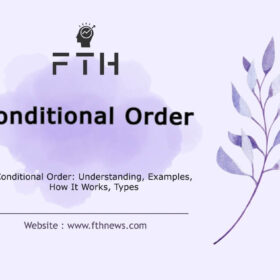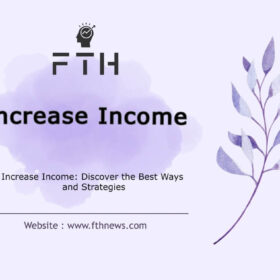
Contingent Order: Understanding, Examples, and How It Works
Contingent Orderr plays a pivotal role in risk management and execution precision. mastering the various order types is crucial for strategic decision-making. In this guide, we will delve into the nuances of Contingent Orders, exploring what they are, how they work, and their significance in the financial landscape.
What Is a Contingent Order?
A Contingent Order is a sophisticated trading order that hinges on the occurrence of a specific event. It remains inactive until the predetermined condition is met, at which point it becomes live and is executed. To illustrate, let’s consider a common example – the stop-loss order. The execution of a stop-loss order is contingent upon the security first being bought.
How Contingent Order Work:
Understanding the intricacies of Contingent Orders involves navigating through various scenarios, each playing a crucial role in shaping trading strategies. Let’s delve into the mechanics:
- Simultaneous Execution:
- Contingent Orders may demand the simultaneous execution of multiple transactions. In this scenario, each order is contingent on the others, necessitating cohesive processing. Consider a scenario where a trader wants to buy and sell options simultaneously – the contingent nature ensures that these actions occur simultaneously or not at all.
- Dependency on Other Orders or Events:
- Contingent Orders can depend on the execution of other orders, creating a cascade effect. For instance, a trader might set an options buy order contingent upon being filled on a stock buy order. Only when the stock purchase is executed will the options order be set in motion.
- Criteria-Based Contingencies:
- Contingent Orders are often based on specific criteria such as price, volume, or time. For example, an order might be contingent upon a security reaching a predetermined price, having a specific volume, and meeting these conditions within certain hours of the trading day. This criterion-driven approach adds a layer of sophistication to trading strategies.
Advantages of Contingent Order:
- Precision Execution:
- Contingent Orders excel in precision execution, ensuring that trades are triggered at optimal moments. By setting specific conditions, traders can automate actions, enabling them to enter or exit positions with accuracy.
- Risk Mitigation:
- A standout advantage of Contingent Orders lies in their effectiveness for risk management. Traders can preemptively define conditions that trigger order execution, allowing for swift responses to market fluctuations and minimizing potential losses.
- Strategic Flexibility:
- Contingent Orders offer strategic flexibility by allowing for the automation of actions based on market developments. Traders can adapt to changing conditions without manual intervention, ensuring that their strategies remain dynamic and responsive.
Disadvantages of Contingent Orders:
- Automation Risks:
- While automation brings efficiency, it introduces the risk of unexpected market movements triggering orders. Traders must be vigilant, as rapid market changes could lead to executions that deviate from their intended strategy.
- Complexity:
- Contingent Orders, especially in complex trading strategies, can introduce additional complexity. Traders need to carefully monitor these orders to ensure that they align with their overarching strategy. The intricacies of simultaneous and criteria-based contingencies may require a nuanced understanding.
In summary, Contingent Orders are a valuable tool in the trader’s arsenal, offering precision, risk management capabilities, and strategic adaptability. However, it’s crucial for traders to be aware of the potential risks and complexities associated with automation, using Contingent Orders judiciously in alignment with their overarching trading goals.
Key Takeaways
1. Conditional Nature
- A Contingent Order is inherently conditional, relying on a predetermined event to trigger its activation.
2. Interconnected Orders
- Multiple orders can be contingent on each other, necessitating simultaneous execution. This complexity allows for intricate trading strategies.
3. Orders Linked to Events
- Contingent Orders can also be tied to specific events or other orders. For instance, a stop-loss order may automatically activate once a trade has been entered.
Practical Examples of Contingent Orders
Scenario 1: Stop-Loss Contingency
Imagine you’ve initiated a trade by buying a security. To manage potential losses, you can set a Contingent Order in the form of a stop-loss. This order will only come into play if the security’s price reaches a predetermined level, ensuring a timely response to adverse market movements.
Scenario 2: Simultaneous Execution
In more complex trading strategies, multiple Contingent Orders can be linked, requiring simultaneous execution. This interconnected approach enables traders to navigate intricate market scenarios with precision.
Why Contingent Orders Matter
1. Risk Mitigation
Contingent Orders act as a powerful tool for risk mitigation. By setting predefined conditions for order execution, traders can minimize potential losses in volatile markets.
2. Precision in Execution
In fast-paced markets, timing is everything. Contingent Orders allow for precise execution, ensuring that trades are triggered at the optimal moment.
3. Strategic Flexibility
The conditional nature of Contingent Orders provides traders with strategic flexibility. It allows for the automation of specific actions based on market developments.
Understanding the Contingent Order
At its core, a Contingent Order is not a standalone directive; it is contingent on specific conditions or events unfolding before it can be processed. Let’s break down the different facets of Contingent Orders:
1. Simultaneous Execution Orders
- Contingent Orders may involve the simultaneous execution of two or more transactions. In this scenario, all orders are contingent on each other, requiring simultaneous processing.
2. Dependency on Another Order or Event
- A Contingent Order can depend on the execution of another order. For instance, a trader might make an options buy order contingent upon being filled on a stock buy order. The execution of the options order is contingent on owning the stock.
3. Criteria-Based Contingency
- Contingent Orders can hinge on specific criteria such as price, volume, time, or other factors. For example, an order might be contingent upon a security reaching a certain price, having a specific volume, and meeting these conditions within specific hours of the day.
In the case of simultaneous transactions, orders remain pending until they can be executed at the same time, highlighting the interdependence inherent in Contingent Orders.
Contingent Order Uses
Contingent Orders are invaluable tools for traders looking to implement strategic moves or manage multiple positions seamlessly. The uses of Contingent Orders are manifold:
1. Risk Mitigation and Strategy Implementation
- Contingent Orders allow traders to implement strategies or execute multiple positions once the initial event occurs. This strategic approach prevents vulnerability to losses or rapid changes in price.
2. Bracketed Orders for Precise Execution
- A classic example is the bracketed order, where a trader wants to buy a stock at a specific price, set a stop loss at a slightly lower price, and a sell order (target) at a slightly higher price. Contingent Orders ensure that whether the stock moves up or down, orders are in place to capture profit and control risk.
3. Overcoming Platform Limitations
- Contingent Orders address challenges associated with manual execution. Attempting to place sell orders both above and below the purchase price manually might be restricted by trading platforms. Contingent Orders intelligently manage these limitations, ensuring orders are placed seamlessly.
4. Broker Integration and Functionality
- Most brokers offer Contingent Order functionality through various order types like basket orders, multi-leg option orders, or bracket orders. Traders input the desired sequence of events and set parameters for contingent orders, enhancing precision and efficiency.
Contingent Order Example in the Options Market
Contingent Orders find widespread application in the options market, where complex trades with multiple legs are common. Consider the buy-write strategy, involving the simultaneous purchase of a long stock position and the writing of a call option. A Contingent Order ensures that the long stock position is opened precisely when the call option is written, mitigating risks associated with separate transactions.
In essence, Contingent Orders are the linchpin that binds intricate trading strategies together, providing traders with the tools to navigate markets with confidence and precision. Mastering the use of Contingent Orders empowers traders to proactively manage risks, seize opportunities, and stay ahead in the dynamic world of finance.
As you embark on your journey in the financial markets, let Contingent Orders be your strategic ally, offering a roadmap to enhanced trading success.
Conclusion
In the ever-evolving landscape of financial markets, understanding and leveraging advanced order types like Contingent Orders is a key aspect of successful trading. By incorporating these conditional orders into your strategy, you gain the ability to navigate market uncertainties with greater precision and control.
Mastering the art of Contingent Orders empowers you to execute trades with confidence, manage risks effectively, and stay ahead in the dynamic world of trading.
Now, armed with this knowledge, seize the opportunity to elevate your trading game by incorporating Contingent Orders into your arsenal.
FAQ
Conditional orders are trading directives that execute based on predetermined conditions or events in the financial markets.
In E*TRADE, a contingent order is a type of trade instruction that becomes active when specific conditions are met.
Setting a conditional order involves specifying criteria, such as price or time, for trade execution. This ensures the order activates when market conditions align.
Contingent trade triggers are events or conditions that activate contingent orders. These triggers could be price movements, volume changes, or other predefined criteria.
A contingent option is a type of financial derivative whose activation or terms depend on the occurrence of specific events or conditions.














